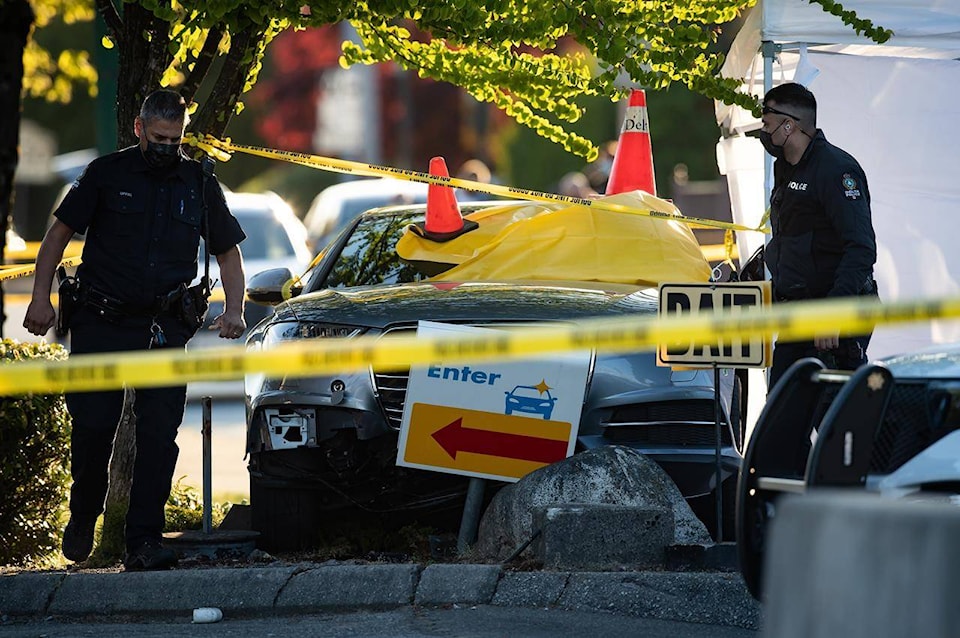The police chief in Delta, B.C., offered comfort to community members following two brazen daytime shootings outside shopping malls on the Lower Mainland, saying officers across the region are working together to solve the crimes.
Chief Neil Dubord acknowledged that many residents are feeling worried after a corrections officer was killed in an attack outside Delta’s Scottsdale Centre mall on Saturday afternoon.
On Monday, RCMP said another man suffered potentially life-threatening injuries in a shooting outside Willowbrook Shopping Centre in Langley, B.C., about 20 kilometres away.
The two incidents have not been linked.
“I want to acknowledge the anxiety I know that many people are feeling in our community in relation to the recent shootings that have happened in the Lower Mainland,” Dubord said during a news conference.
“I want everyone to know that all police departments in the Lower Mainland are working together, supporting each other in their investigations, sharing information, and this is our top priority.”
There was also a targeted attack Sunday in Burnaby on a woman who is expected to survive and a fatal shooting of a 19-year-old man in Surrey, B.C., on Friday.
Dubord says the killing of provincial corrections officer Bikramdeep Randhawa, 29, has all the markings of a gang attack, specifically in the way it was carried out and the torching of a vehicle soon after.
However, he said investigators have not confirmed that link and are exploring all possible motives.
The recent shootings show a “shocking” disregard for public safety, but he assured residents that the community remains safe and solving the crimes is a top priority.
“We’re here to say this is a safe community,” he said.
Dubord also asked members of the public to submit photo or video evidence through a new portal on the department’s website that allows individuals to share information without handing their devices over to police.
The victim of the second shopping-mall shooting has not been identified, but RCMP have said it does not appear random. There is no information linking the shooting of the woman in Burnaby to the gang conflict, they have also said.
Although public shootings support the perception of escalating violence, the statistics don’t necessarily support that, a spokeswoman for British Columbia’s anti-gang unit said.
“It’s obviously concerning when we see very brazen acts of violence in a public setting, which puts the public at risk. However, I can say it’s not something new,” Sgt. Brenda Winpenny of the Combined Forces Special Enforcement Unit B.C. said.
The unit’s new chief officer, Asst. Commissioner Manny Mann, said during a news conference April 22 that annual gang killings had declined between 2017 and 2020 from 49 to 23. There had been 15 gang-related homicides in 2021, he said.
Winpenny did not immediately have an updated figure, but she noted it can take time to link a death to the gang conflict.
On the whole, public violence can happen for several reasons, including retaliation or competition with rival gangs.
The gang landscape has evolved in recent years, with smaller groups working under larger criminal organizations, and younger people getting involved, she said.
Individuals change allegiances and alliances, which causes turmoil and conflict, she added.
“When rival gangs are taking an opportunity to target another individual from a different gang, they don’t care where it happens. They’ll take the opportunity when it presents itself,” Winpenny said.
“They don’t have any regard for anyone’s safety, which is obviously a concern.”
It reinforces the importance of education and the agency’s End Gang Life program, among other preventive measures, she said.
Keiron McConnell, a Lower Mainland police officer and lecturer on organized crime at Simon Fraser University and Kwantlen Polytechnic University, also said public violence isn’t new.
Between 2003 and 2013, roughly 86 per cent of gang homicides in the region occurred in public settings, he said.
Apparent crime spikes are really part of a longer cycle, he added.
“I think it’s like a wave, it comes, it goes. Conflicts occur, conflicts calm down,” he said.
One thing that could be influencing the current conflict is the rise in illicit drug prices, he said.
It means gangs are selling in smaller quantities to lower the possible cost of being ripped off or intercepted by police. But it also means more point-of-sale transactions, and more opportunities to disrupt one another’s transactions, he said.
From McConnell’s perspective, it’s wrong to suggest nothing is being done to prevent the gang violence. There are many effective programs in the region, such as Safer Schools Together and Yo Bro / Yo Girl youth programs, he said.
“We don’t know what it would be like if we didn’t have these programs, it could be a whole lot worse.”
Like us on Facebook and follow us on Twitter.
Want to support local journalism? Make a donation here.
